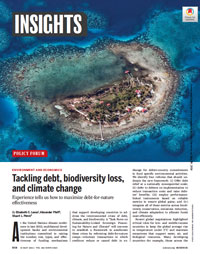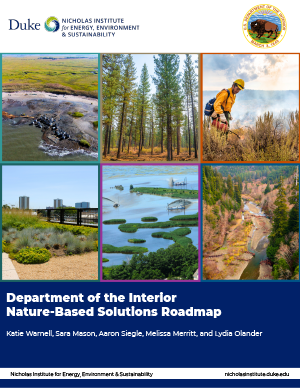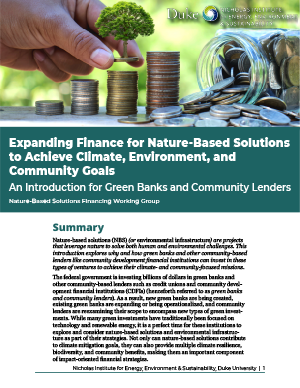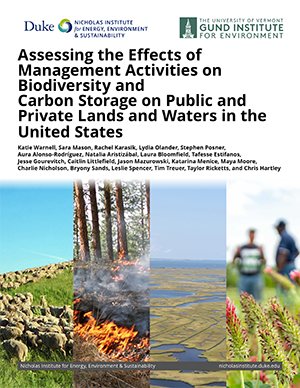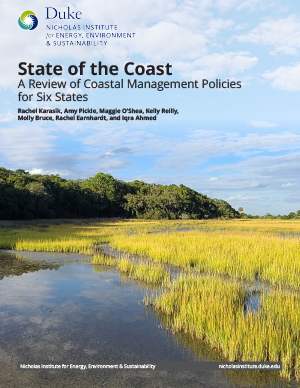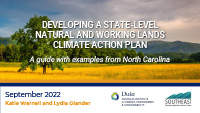Publications
Tackling Debt, Biodiversity Loss, and Climate Change
Debt distress, biodiversity loss and climate change are interconnected crises for developing countries. A task force of multilateral development banks and environmental institutions is convening a task force to establish a framework to ameliorate these crises by reforming debt-for-nature swaps. The authors of this Policy Forum identify four reforms that should underpin the new framework.
Evidence Library for Mangrove Degradation and Recovery
Mangrove ecosystems provide numerous benefits to both people and nature, including providing important habitat for wildlife species, nursery habitat for fish and shellfish, recreational opportunities, and protection for coastal communities. This evidence library synthesizes the scientific literature and expert knowledge to share information on what is known—and not known—about how storm-induced changes to mangrove ecosystems might impact mangrove ecosystem services.
Department of the Interior Nature-Based Solutions Roadmap
This comprehensive resource, created in collaboration with the US Department of the Interior, is a first-of-its-kind reference for implementing nature-based solutions. Nature-based solutions are actions to protect, sustainably manage or restore natural or modified ecosystems to address societal challenges—including climate change—in ways that help people and the environment. Examples cited in the Roadmap range from urban stormwater and runoff management to prescribed burns to living shorelines to restoration of various ecosystems.
Expanding Finance for Nature-Based Solutions to Achieve Climate, Environment, and Community Goals: An Introduction for Green Banks and Community Lenders
There has been unprecedented recent government investment in nature-based solutions. This document lays out a vision that describes why nature-based solutions are relevant and important to green banks' and community development financial institutions' climate- and community-driven missions, and what types of projects these institutions might support.
Financing Nature-Based Solutions via the Greenhouse Gas Reduction Fund
The $27 billion Greenhouse Gas Reduction Fund (GGRF) in the Inflation Reduction Act—particularly the $14 billion National Clean Investment Fund and $6 billion Clean Communities Investment Accelerator—represents a once-in-a-generation opportunity to leverage private capital for investments in environmental infrastructure and nature-based solutions, but the groundwork needs to be laid now. This document summarizes the relevant GGRF funds and their applicability for nature-based solutions.
Assessing the Effects of Management Activities on Biodiversity and Carbon Storage on Public and Private Lands and Waters in the United States
Natural and working lands (NWLs) provide many benefits to people, including storing greenhouse gases (GHGs), supporting biodiversity, and generating other ecosystem services. Management of NWLs can influence their condition and function and therefore the benefits they provide. This project surveys the synthesis literature to assess how management actions on various types of NWLs affect biodiversity and GHG outcomes. This information can help to determine how to best manage these lands to contribute to both biodiversity and climate solutions in the United States.
State of the Coast: A Review of Coastal Management Policies for Six States
This analysis of coastal habitat policy in six US states—California, Florida, Massachusetts, North Carolina, Texas, and Washington—aims to identify promising policy approaches for improved protection and restoration of oyster reefs, mangroves, salt marshes, and seagrass.
Developing a State-Level Natural and Working Lands Climate Action Plan
Natural and working lands—forests, wetlands, coastal, and agricultural lands—provide many benefits, including supporting key economic sectors, enhancing community resilience to hazards such as fires and floods, and contributing to climate mitigation by storing large amounts of carbon. This guide is aimed at states interested in developing plans for conserving, managing, and restoring these lands to preserve and enhance their benefits. The guide uses examples from North Carolina’s recently completed Natural and Working Lands Action Plan to walk through the planning process, helpful resources, and the tracking of plan implementation.
Sea Level Rise Drives Carbon and Habitat Loss in the U.S. Mid-Atlantic Coastal Zone
As the climate changes, marshes on the Atlantic coast will migrate inland and cause even more carbon to be released into the atmosphere, a new modeling study finds. Researchers developed a spatial model for predicting habitat and carbon changes due to SLR in six mid-Atlantic U.S. states likely to face coastal habitat loss. The modeling runs looked at land changes in coastal areas through the year 2104 in scenarios that predict intermediate sea level rise. In 16 out of the 19 runs of the model, inland marsh migration converted land from a net carbon sink to a net carbon source.
A Menu of State Actions to Promote Forest Carbon Sequestration and Storage
Across the U.S., states are developing policies and programs to help promote forest-based natural climate solutions. This effort is bolstered by a growth in forest carbon programs that aim to make entry into the voluntary carbon offset market accessible to all landowners. Here we present a “menu” of policy and program options (that we call action items) derived from existing state programs and policies that decision makers can leverage to promote forest carbon solutions.

